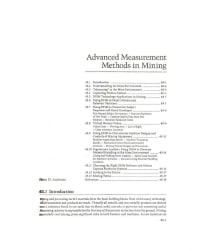Mining Publication: Advanced Measurement Methods in Mining
Original creation date: November 2008
Authors: DH Ambrose
NIOSHTIC2 Number: 20034932
Handbook of Digital Human Modeling: Research for Applied Ergonomics and Human Factors Engineering. Duffy VG, ed., Boca Raton, FL: CRC Press, 2008 Nov; :43.1-43.21
Mining and processing materials from the earth form the basic building blocks from which many technological advancements and products are made. Virtually all metallic and non-metallic products are derived from a substance found in our earth that we blend, mold, extrude, or pulverize into something useful. The mining industry is responsible for the first step of this process: extraction from the ground. Mining, particularly coal mining, poses significant risks to both humans and machines. As, raw materials are forcibly broken or blasted apart, then roughly yet effectively excavated by large transport vehicles or by vertical and incline hoists , human operators must battle noise, dust, mud, and darkness while controlling and maintaining their machinery and keeping themselves and their crews safe from harm. Such a hazardous work environment poses extraordinary challenges to mine operators who must vigilantly recognize and control the perils of mining. While mining is essential to the progress and productivity of our society, the early years of mining was characterized by miners' poor health, common accidents, and environmental impacts. Poor safety and health practices were costly in both personal injuries and property damage. Thanks to safety and environmental regulations and diligence from the mining community, mining safety records have significantly improved over the last 50 years, and progress in this area continues. As digital human modeling (DHM) has been more prevalently used by human factors and ergonomics professionals to analyze workplace hazards and improve workplace design (Brown. 1999; Badler et. al. 2002; Chaffin, 2002; Maatta, 2003; Ferguson & Marras, 2004, Colombo & Cugini, 2005; Zhang & Chaffin, 2006), the National Institute for Occupational Safety and Health (NIOSH) Pittsburgh Research Laboratory (PRL) also saw the benefits to using DHM in their computer-simulated mining environments. This chapter features how researchers use DHM to assess and ultimately decrease the occupational risk and threats faced by underground coal mine machine operators.

NIOSHTIC2 Number: 20034932
Handbook of Digital Human Modeling: Research for Applied Ergonomics and Human Factors Engineering. Duffy VG, ed., Boca Raton, FL: CRC Press, 2008 Nov; :43.1-43.21
- Development and Application of Reservoir Models and Artificial Neural Networks for Optimizing Ventilation Air Requirements in Development Mining of Coal Seams
- I Can't Get Enough Air! Proper Self-contained Self-rescuer Usage
- Modeling and Prediction of Ventilation Methane Emissions of U.S. Longwall Mines Using Supervised Artificial Neural Networks
- Modernization and Further Development of the NIOSH Mine Emergency Response Training System (MERITS), Phase 1
- SPONCOM - A Computer Program for the Prediction of the Spontaneous Combustion Potential of an Underground Coal Mine
- Task Analysis
- Technology News 535 - NIOSH Releases New Educational Video: Escape from Farmington No. 9: An Oral History
- Technology News 545 - NIOSH Updates Spontaneous Combustion Assessment Software
- Technology News 549 - MFIRE 3.0 - NIOSH Brings MFIRE into 21st Century
- Working in the Classroom - A Vision of Miner Training in the 21st Century